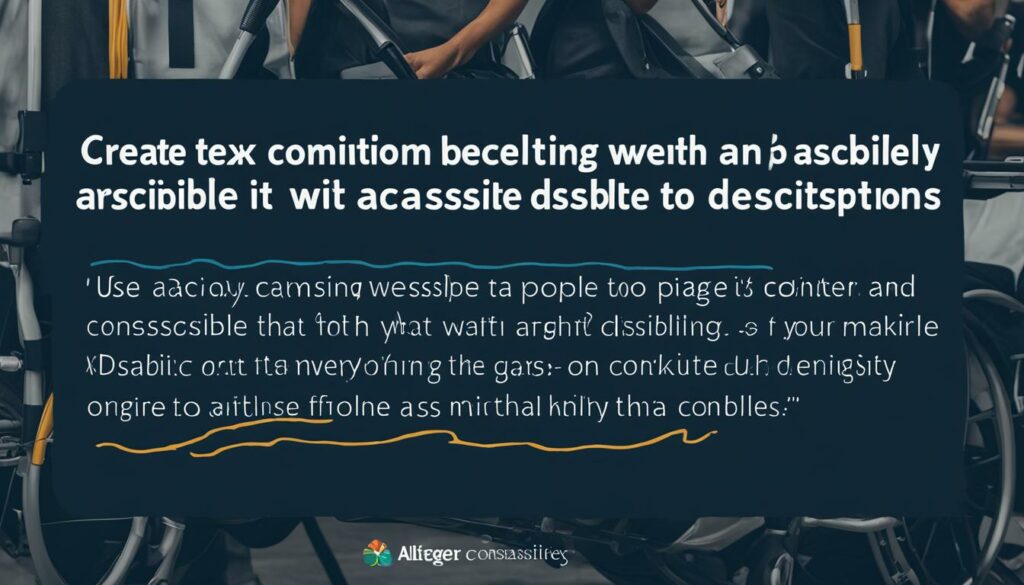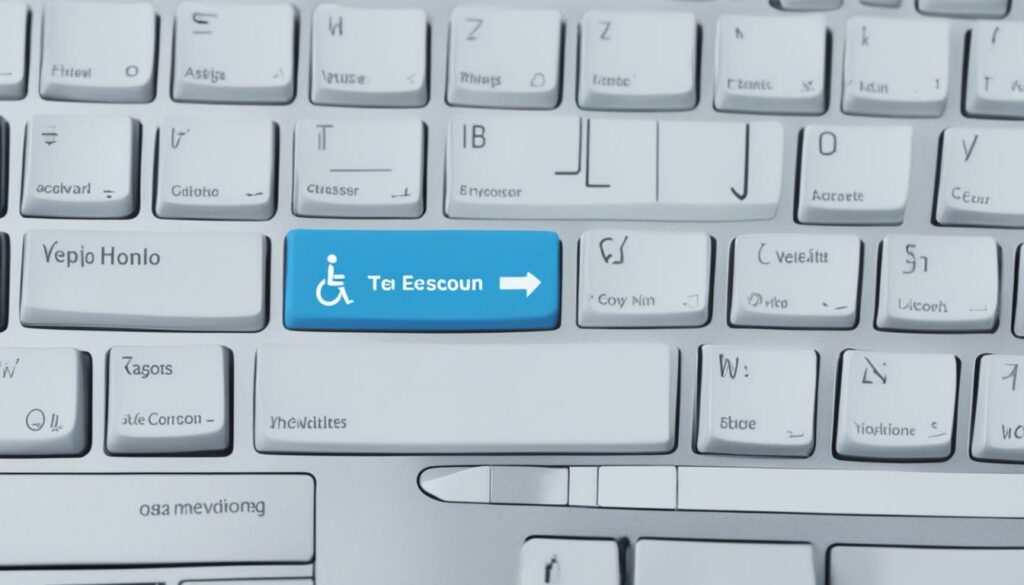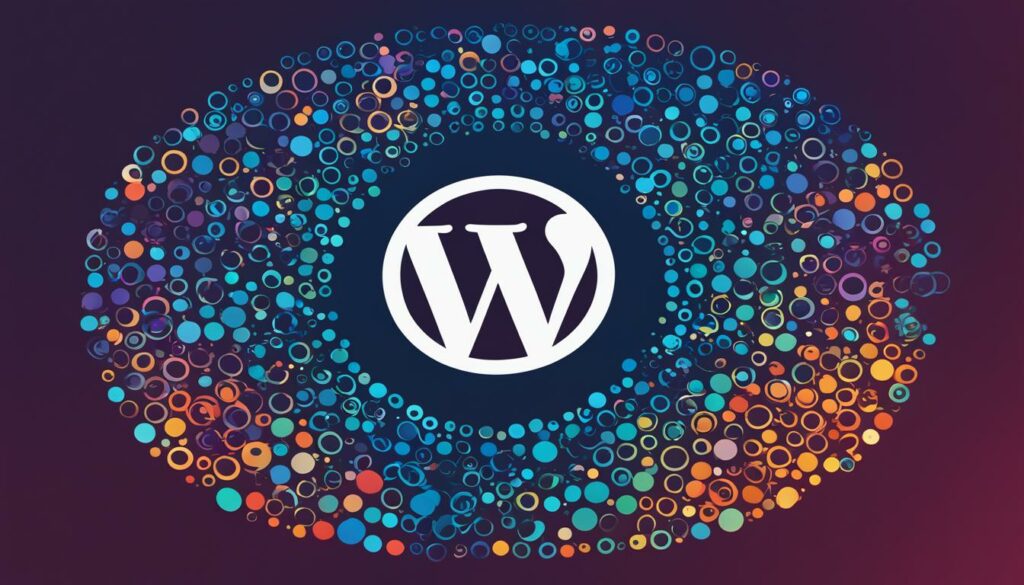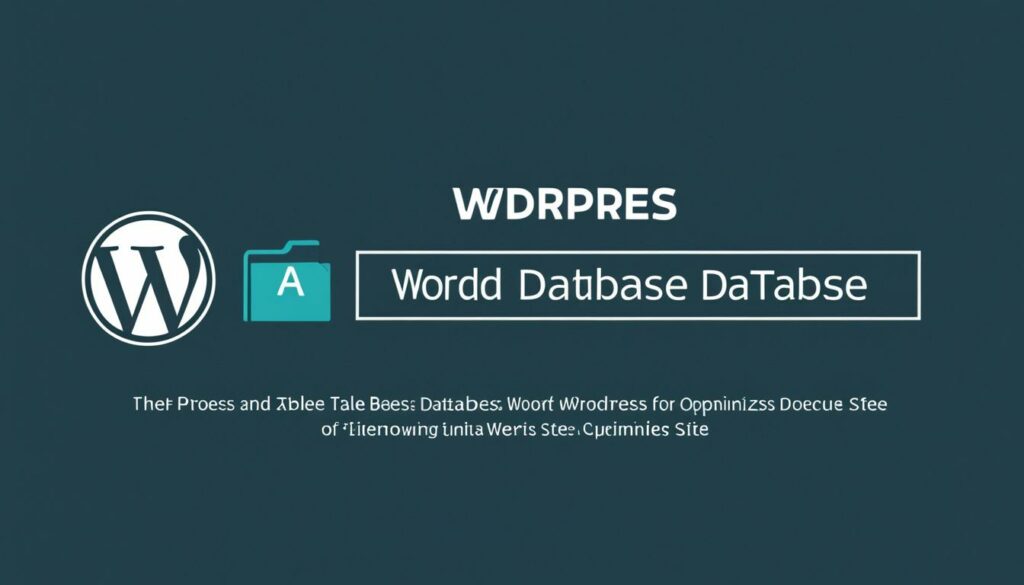Welcome to the world of WordPress! As you embark on your website development journey, it’s important to consider the accessibility of your site. By making your WordPress site accessible, you can ensure that it is open for everyone, including those with disabilities.
Web accessibility is about creating an inclusive online experience, where individuals of all abilities can navigate, interact, and engage with your content. It not only aligns with the WordPress Accessibility Standards but also with the requirements set forth by the ADA (Americans with Disabilities Act) and the WCAG (Web Content Accessibility Guidelines).
When your WordPress site is accessible, it accommodates various assistive technologies and provides features like screen reader compatibility, keyboard navigation, and optimized alt text for images. This allows users with disabilities to perceive, understand, navigate, and interact with your content smoothly.
To achieve this, you need to follow inclusive design principles and adopt accessible website development practices. Luckily, WordPress offers resources and guidelines to help you along the way. The WordPress Accessibility Team provides expertise and best practices through their Accessibility Handbook, ensuring that you have the necessary knowledge to build an accessible website.
In this article, we will explore the importance of WordPress accessibility, discuss ways to make your WordPress site accessible, and provide insights into testing your site for accessibility. Let’s dive in and ensure your WordPress site is truly open for everyone!
Key Takeaways
- WordPress Accessibility Standards ensure that everyone, including people with disabilities, can access and interact with your website.
- Web accessibility is crucial for inclusive design, ADA compliance, and aligning with WCAG guidelines.
- WordPress provides resources and guidelines through the Accessibility Handbook to help you improve the accessibility of your site.
- Accessible features like screen reader compatibility, keyboard navigation, and optimized alt text enhance the user experience for individuals with disabilities.
- By prioritizing WordPress accessibility, you create an inclusive online experience that benefits all users.
Continue reading to discover how you can make your WordPress site accessible and ensure it meets the highest accessibility standards.
Is WordPress Accessibility-Ready?
When it comes to WordPress Accessibility Standards, ensuring your website is accessible to all users is crucial. WordPress expects code integrated into its ecosystem to conform to WCAG 2.1 AA standards. However, not all themes marked as “Accessibility Ready” meet AA compliance. As a website owner, the responsibility of ensuring the accessibility of your WordPress site falls on you.
Fortunately, the WordPress Accessibility Team has compiled a list of accessibility-ready themes that meet the basic accessibility requirements. By choosing an accessible theme, you can lay the foundation for an inclusive and user-friendly website. These themes prioritize inclusive design, screen reader compatibility, keyboard navigation, and alt text optimization.
Why is WordPress Accessibility Important?
Creating an accessible website goes beyond meeting legal requirements, such as ADA compliance. It is about making your website usable for all individuals, regardless of their abilities. By adhering to WCAG guidelines and emphasizing inclusive design principles, you can enhance user experience, improve usability, and reach a wider audience.
Accessible website development not only benefits people with disabilities but also contributes to a positive user experience for all visitors. Additionally, search engines favor accessible websites, resulting in better search engine rankings and increased organic traffic.
Building an inclusive online space is not just the right thing to do, it’s also good for your business. By creating an accessible website, you ensure that you do not miss out on potential customers and opportunities.
Screen Reader Compatibility and Keyboard Navigation
One of the key aspects of web accessibility is ensuring compatibility with screen readers and enabling keyboard navigation. Screen readers assist visually impaired users in accessing website content by reading aloud the text displayed on the screen. Keyboard navigation allows users to navigate through a website using only their keyboard, without requiring a mouse or other pointing device. By optimizing your WordPress site for these features, you can ensure that all users can access your content seamlessly.
Optimizing Alt Text
Another essential step in making your WordPress site accessible is optimizing alt text for images. Alt text provides a text alternative to images, allowing screen readers to convey the image description to visually impaired users. By writing descriptive and meaningful alt text, you make your website more inclusive and provide a better user experience for all visitors.
WordPress Accessibility-Ready Themes
The accessibility-ready themes identified by the WordPress Accessibility Team have undergone testing and meet basic accessibility requirements. These themes prioritize inclusive design and functionality, helping you create an accessible website without compromising on style or functionality.
Check out the screenshot below for a glimpse of a few popular accessibility-ready themes for WordPress:
| Theme Name | Accessibility Features |
|---|---|
| Theme 1 | Screen reader compatibility, keyboard navigation, color contrast |
| Theme 2 | Alt text optimization, inclusive design, WCAG compliance |
| Theme 3 | Keyboard navigation, accessible color palette, semantic code |
By selecting an accessibility-ready theme, you can ensure that your WordPress site meets the basic accessibility requirements and provides an inclusive experience for all users.
Why WordPress Accessibility Matters
It is crucial to prioritize WordPress accessibility because there are over a billion people with disabilities worldwide. Accessibility encourages better design practices, improves usability, and can positively impact a website’s search engine ranking. Inaccessibility can result in missed business opportunities and potential lawsuits. It is important to create an accessible website that benefits all users, not just those with disabilities.
Including everyone benefits everyone.
When your WordPress site meets WordPress Accessibility Standards, you ensure that people with disabilities can access and navigate your content effectively. This inclusivity fosters a positive user experience and broadens your audience reach.
Web accessibility is not just about complying with regulations like the Americans with Disabilities Act (ADA). It is about promoting equal access to information and services for everyone, regardless of their abilities.
An accessible website is a powerful tool for businesses and organizations, as it helps:
- Expand your customer base
- Increase user engagement and satisfaction
- Enhance brand reputation and credibility
- Improve SEO and search engine visibility
Building an accessible WordPress site means adhering to the Web Content Accessibility Guidelines (WCAG). These guidelines provide a comprehensive framework for achieving inclusive design and accessible website development.
Screen Reader Compatibility and Keyboard Navigation
Screen readers are assistive technologies that read web content aloud for individuals with visual impairments. By ensuring screen reader compatibility, you make your content accessible to a wider audience.
Keyboard navigation is another essential aspect of web accessibility. Some users rely on keyboard-only navigation due to motor disabilities. Making sure that all website features and functionalities can be accessed and operated using a keyboard promotes inclusivity.
Optimizing Alt Text
Alt text, or alternative text, is descriptive text associated with images. It plays a crucial role in making visual content accessible to people with visual impairments or those using assistive technologies. Including relevant and descriptive alt text in your WordPress site improves accessibility and ensures that users understand the meaning conveyed by images.

Inclusive Design and User Experience
Embracing inclusive design principles means considering the diverse needs and abilities of all users when designing and developing your WordPress site. By prioritizing inclusive design, you create user-centric experiences that accommodate a wide range of users.
A well-designed and accessible website improves usability for everyone. It enhances the overall user experience, making it easier for visitors to navigate and interact with your content.
Remember, WordPress accessibility helps establish an online space that is open and welcoming to all users, fostering inclusivity and reflecting your commitment to equal access and usability.
How to Make Your WordPress Site Accessible
Ensuring that your WordPress site is accessible is essential to provide an inclusive online experience for all users. By following the WordPress Accessibility Standards and implementing web accessibility best practices, you can create a website that is ADA compliant and meets WCAG guidelines.
Familiarize Yourself with Guidelines
To begin, familiarize yourself with the essential guidelines for web accessibility. The World Wide Web Consortium (W3C), Web Accessibility Initiative (WAI), and WCAG provide comprehensive resources and guidelines for creating accessible websites. Understanding these guidelines will help you make informed decisions during the development process.
Select an Accessibility-Ready Theme
Choosing an accessibility-ready theme is an efficient way to ensure that your website meets the necessary criteria. An accessibility-ready theme is designed with inclusive design principles and WCAG standards in mind. Research and select a theme that is labeled as accessibility-ready to save time and effort in making your site accessible.
Consider WordPress Accessibility Plugins
In addition to an accessibility-ready theme, consider installing WordPress accessibility plugins. These plugins offer additional features and functionality to enhance the accessibility of your website. Some popular accessibility plugins include Accessibility Toolbar, WP Accessibility, and WP ADA Compliance Check Basic.
Optimize Code and Captions for Media
Make sure that your code follows accessibility best practices, including proper heading structures, descriptive link text, and semantic HTML elements. When using images, GIFs, and videos, provide descriptive alt text and captions to allow screen reader users to understand the content.
Ensure Keyboard Navigation and Accessible Design
Keyboard navigation is vital for users who rely on assistive technology or have mobility impairments. Ensure that all interactive elements on your website, such as menus and forms, can be accessed and used solely with a keyboard. Choose accessible colors and fonts that provide sufficient contrast and are legible for users with visual impairments.
Prioritize Content Accessibility
Make your content accessible by using clear and concise language, organizing information with proper headings, and providing alternative text for non-text content. Avoid auto-playing videos, as they can be distracting and disruptive for users with cognitive disabilities. Use clear and simple layouts to enhance readability and comprehension.
Regularly Test for Accessibility
Testing your website regularly is essential to ensure ongoing accessibility. Use automated tools like the WAVE Web Accessibility Evaluation Tool to identify potential issues. Additionally, perform manual testing and involve users with disabilities to gain valuable insights and feedback on the usability and accessibility of your site.
| Accessibility Task | Recommended Tool |
|---|---|
| Automated Evaluation | WAVE Web Accessibility Evaluation Tool |
| Manual Evaluation | Review code and conduct manual accessibility checks |
| User Testing and Feedback | Involve users with disabilities for usability testing |

By taking these steps, you can make your WordPress site accessible to a wider audience, including individuals with disabilities. Providing an inclusive and user-friendly experience not only enhances usability but also ensures compliance with accessibility standards and regulations.
How Accessible is WordPress out of the Box?
Despite WordPress’s commitment to improving accessibility, there are still areas that require attention. The WordPress Accessibility Team is working towards making the WordPress Admin and bundled themes fully WCAG 2.0 AA compliant. However, it is important to note that there are known issues that need to be addressed.
One such issue is the accessibility challenges faced with the new Gutenberg editor. Although progress is being made to improve its accessibility, there is still work to be done. Therefore, it is crucial that you conduct your own testing to ensure that your WordPress site meets accessibility standards.
By conducting thorough testing, you can identify any potential barriers or issues that may prevent users from accessing your site effectively. This includes evaluating screen reader compatibility, keyboard navigation, and alt text optimization. Ensuring that all users, regardless of ability, can navigate and interact with your website is essential for providing an inclusive online experience.
Testing your website’s accessibility can be achieved by employing a combination of automated tools, manual evaluation, and user testing. Automated tools such as the WAVE Web Accessibility Evaluation Tool and the Accessibility Insights for Web browser extension can help pinpoint initial accessibility issues.
However, it is essential to supplement automated testing with manual evaluation to identify potential issues that may be missed. Additionally, involving users with disabilities in the testing process provides invaluable insights into the usability and accessibility of your site.
By striving for accessibility and adhering to WordPress Accessibility Standards, you can ensure that your website provides an inclusive experience for all users. Taking the necessary steps to optimize your site for web accessibility not only benefits users with disabilities but also improves the overall user experience and search engine visibility. When everyone can access and engage with your content, you broaden your reach and create a more inclusive online environment.
Accessible Websites in WordPress
Building an accessible website is crucial to ensure that all users can access and interact with your content. In WordPress, creating an accessible website involves selecting a theme that meets WordPress Accessibility Standards, optimizing color contrast, and prioritizing code accessibility. Whether you’re using pre-built themes or creating a custom design, here are some key considerations:
Research and Test Accessible Themes
When choosing a theme for your WordPress website, it’s important to research and test for accessibility. Look for themes that explicitly state compliance with WCAG guidelines and WordPress Accessibility Standards. Test the themes for screen reader compatibility, keyboard navigation, and overall usability to ensure a seamless experience for all users.
Create an Accessible Custom Theme
If you’re creating a custom theme from scratch, start with a solid foundation like the Underscores starter theme, which promotes accessibility best practices. Pay attention to color contrast, ensuring that text is easily readable against the background. Prioritize code accessibility by using semantic HTML and providing proper headings, landmark roles, and focus indicators for interactive elements.

Regular Testing and Adherence to Guidelines
Regularly test your website for accessibility using automated tools like WAVE Web Accessibility Evaluation Tool and manual evaluations. Check for any issues related to keyboard navigation, tab order, alt text optimization, video captions, and form accessibility. Adhere to WCAG guidelines and consider involving users with disabilities to provide feedback and insights on usability.
“Creating an accessible website goes beyond compliance – it allows you to reach a wider audience and provide a better user experience for everyone.”
By building an accessible website in WordPress, you demonstrate a commitment to inclusivity and ensure that all visitors can access and engage with your content. Remember to choose accessible themes, prioritize color contrast and code accessibility, and conduct regular testing to maintain an optimal user experience for all.
Building an Accessible Theme
When it comes to building a custom WordPress theme, prioritizing accessibility is key. By considering elements such as color contrast, code accessibility, and adherence to WCAG guidelines, you can create a theme that is inclusive and user-friendly.
A good starting point for your accessible theme is the Underscores starter theme. This reliable base provides a solid foundation for your customization efforts, ensuring that accessibility remains a priority throughout the development process.
During the design phase, make conscious decisions to enhance accessibility. Consider factors like keyboard navigation and screen reader compatibility, ensuring that all users can easily navigate and engage with your theme.
Thorough testing is crucial in the development of an accessible theme. Ensure that all elements, including links, are properly marked and distinguishable. By following best practices and conducting comprehensive testing, you can create a theme that meets WordPress Accessibility Standards.
“Accessibility is not a nice-to-have. It is a must-have for any website or theme. By prioritizing accessibility in your theme development process, you are making a positive impact and opening doors for all users.”
To further illustrate the impact of building an accessible theme, let’s look at a comparison of two themes:
| Theme | Accessible | Non-Accessible |
|---|---|---|
| Color Contrast | Meets WCAG guidelines, offering adequate contrast for all users. | Does not meet WCAG guidelines, making it difficult for users with visual impairments to read content. |
| Code Accessibility | Adheres to WCAG guidelines, ensuring screen readers can interpret content correctly. | Contains inaccessible code, resulting in screen readers misinterpreting content or omitting important information. |
| Navigation | Provides clear and easy-to-use keyboard navigation, promoting usability for all users. | Requires extensive mouse usage, creating barriers for users with motor disabilities. |
By prioritizing accessibility in your theme development, you are not only promoting inclusivity but also enhancing user experience and ensuring compliance with WordPress Accessibility Standards.
So, when building your custom WordPress theme, remember to prioritize adequate color contrast, code accessibility, and adherence to WCAG guidelines. Start with a reliable base like the Underscores starter theme, consider accessibility in design decisions, conduct thorough testing, and follow best practices. By doing so, you can contribute to an accessible web and provide an inclusive experience for all users.
Next, we’ll explore how you can conduct accessibility testing on your WordPress site to ensure it meets the highest standards.
Conducting Accessibility Testing on Your WordPress Site
To ensure the accessibility of your WordPress site, you need to conduct regular testing. This involves using a combination of automated tools, manual evaluation, and user testing. By employing these testing methods, you can identify and address any accessibility issues, ensuring that your website meets the WordPress Accessibility Standards.
Automated Tools
Automated accessibility testing tools can scan your website to identify potential accessibility issues. One such tool is the WAVE Web Accessibility Evaluation Tool. It analyzes the HTML code and provides a comprehensive report highlighting areas that need improvement. Another useful tool is the Accessibility Insights for Web browser extension, which offers a range of accessibility checks and provides actionable recommendations.
Manual Evaluation
While automated tools can catch many accessibility issues, there are some that may be missed. Conducting manual evaluations allows you to go beyond the automated reports and identify any additional issues. It involves reviewing your website’s design, content, and functionality with accessibility guidelines in mind. Look for elements that may present challenges for users with disabilities, such as complex navigation menus or unclear instructions.
User Testing
Involving users with disabilities in the testing process is essential. They can provide valuable feedback on the accessibility and usability of your site. Work with individuals who use assistive technologies, such as screen readers, to navigate your website. Their insights can help uncover any barriers or challenges that may exist. Additionally, observe how users interact with your site and consider their feedback to make improvements.
| Automated Tools | Manual Evaluation | User Testing |
|---|---|---|
| Scans HTML code for accessibility issues | Identifies issues missed by automated tools | Provides insights from users with disabilities |
| Examples: | Examples: | Examples: |
| – WAVE Web Accessibility Evaluation Tool | – Review website design | – Observe users with assistive technologies |
| – Accessibility Insights for Web browser extension | – Evaluate content accessibility | – Gather feedback from users |
By incorporating these testing methods into your website development process, you can ensure that your WordPress site meets the WordPress Accessibility Standards. Regular testing and improvements will help create an inclusive and accessible online experience for all users.
BoostedHost offers WordPress Hosting that can optimize the performance of your accessible website. Sign up now through this link.
Conclusion
Prioritizing WordPress Accessibility Standards is crucial to provide an inclusive and accessible online experience for all users. By adhering to WCAG guidelines, choosing accessible themes and plugins, optimizing code and content, and regularly testing your website, you can ensure that your WordPress site meets the highest accessibility standards.
Creating an inclusive online space benefits everyone and helps you reach a wider audience. Web accessibility is not only about complying with regulations like ADA, but it is also about embracing inclusive design principles and ensuring that all users, regardless of their abilities, can access and navigate your website effectively.
Screen reader compatibility and keyboard navigation are essential for users with visual impairments or motor disabilities. Optimizing alt text for images and videos ensures that visually impaired users can understand and engage with your content. With an accessible website, you not only cater to the needs of users with disabilities, but you also enhance the overall user experience for all visitors.
Remember, achieving accessibility is an ongoing process. Regularly reviewing and testing your website for accessibility issues is crucial to identify and address any barriers that may arise. By embracing WordPress Accessibility Standards, you demonstrate a commitment to inclusivity and ensure that everyone can fully engage with your website and its content.
FAQ
Q: Is WordPress an accessible platform?
A: WordPress is committed to being as inclusive and accessible as possible. The WordPress community aims to make the WordPress Admin and bundled themes fully WCAG 2.0 AA compliant. The WordPress Accessibility Team provides expertise to improve the accessibility of WordPress core and resources.
Q: Are all themes marked as “Accessibility Ready” compliant with accessibility standards?
A: Not all themes marked as “Accessibility Ready” meet AA compliance. While WordPress expects code integrated into its ecosystem to conform to WCAG 2.1 AA standards, the responsibility of ensuring the accessibility of a WordPress site lies with the owner. The WordPress Accessibility Team has a list of accessibility-ready themes that meet the basic accessibility requirements.
Q: Why is it important to prioritize WordPress accessibility?
A: It is crucial to prioritize WordPress accessibility because there are over a billion people with disabilities worldwide. Accessibility encourages better design practices, improves usability, and can positively impact a website’s search engine ranking. Inaccessibility can result in missed business opportunities and potential lawsuits. Creating an accessible website that benefits all users is essential.
Q: How can I make my WordPress site accessible?
A: To ensure your WordPress site is accessible, familiarize yourself with the W3C, WAI, and WCAG guidelines. Choose an accessibility-ready theme and consider installing a WordPress accessibility plugin. Make sure your code is accessible and use proper captions for images, GIFs, and videos. Ensure keyboard navigation and choose accessible colors and fonts. Pay attention to content accessibility, avoid auto-playing videos, and use clear and simple layouts. Regularly test your website for accessibility.
Q: How accessible is WordPress out of the box?
A: WordPress is committed to improving accessibility, but there are still areas that need work. The WordPress Accessibility Team aims to make the WordPress Admin and bundled themes fully WCAG 2.0 AA compliant, but there are known issues. The new Gutenberg editor has had accessibility issues, although progress is being made. It is essential to conduct your own testing and ensure that your WordPress site is accessible.
Q: Can I build an accessible website using WordPress?
A: Yes, you can build an accessible website using WordPress. The accessibility of your WordPress website relies on selecting an accessible theme and ensuring adequate color contrast and code accessibility. Research and test themes, both free and premium, to find the most accessible option. If you are creating a custom theme, start with a solid foundation and prioritize color contrast and code accessibility. Regular testing and adherence to guidelines will help maintain an accessible website.
Q: How can I build an accessible theme in WordPress?
A: When building a custom WordPress theme, prioritize adequate color contrast, code accessibility, and adherence to WCAG guidelines. Start with a reliable base like the Underscores starter theme and consider accessibility in design decisions. Conduct thorough testing and ensure that elements like links are properly marked and distinguishable. Following best practices will contribute to an accessible theme.
Q: How can I test the accessibility of my WordPress site?
A: To ensure the accessibility of your WordPress site, conduct regular testing using a combination of automated tools, manual evaluation, and user testing. Use tools like the WAVE Web Accessibility Evaluation Tool and the Accessibility Insights for Web browser extension. Perform manual evaluations to identify issues that may be missed by automated tools. Finally, involve users with disabilities to provide feedback and test the usability of your site.
Q: Why should I prioritize WordPress Accessibility Standards?
A: Prioritizing WordPress Accessibility Standards is crucial to provide an inclusive and accessible online experience for all users. By adhering to WCAG guidelines, choosing accessible themes and plugins, optimizing code and content, and regularly testing your website, you can ensure that your WordPress site meets the highest accessibility standards. Creating an inclusive online space benefits everyone and helps you reach a wider audience.












